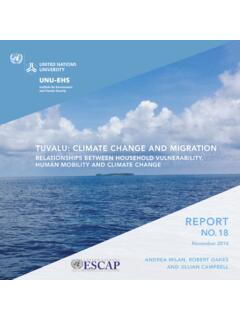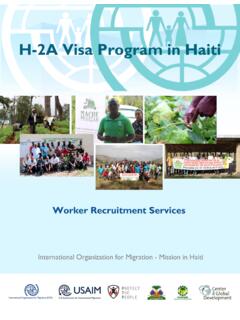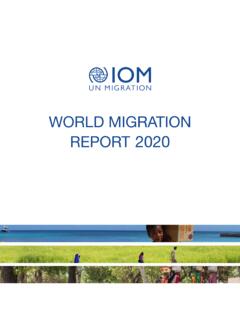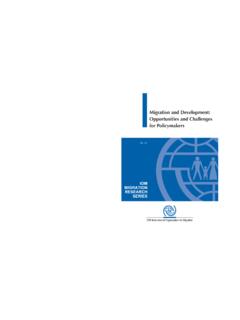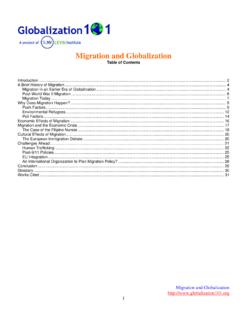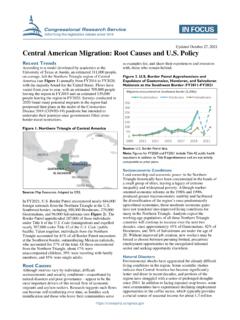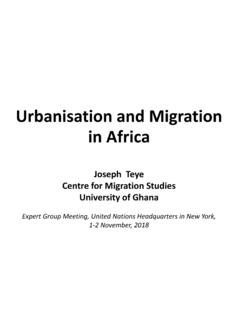Transcription of 2017 International Migration - Un
1 2017. International Migration Report United Nations [highlights]. < this page intentionally left blank >. ST/ Department of Economic and Social Affairs International Migration Report 2017. Highlights United Nations New York, 2017. The Department of Economic and Social Affairs of the United Nations Secretariat is a vital interface between global policies in the economic, social and environmental spheres and national action. The Department works in three main interlinked areas: (i) it compiles, generates and analyses a wide range of economic, social and environmental data and information on which States Members of the United Nations draw to review common problems and take stock of policy options; (ii) it facilitates the negotiations of Member States in many intergovernmental bodies on joint courses of action to address ongoing or emerging global challenges.
2 And (iii) it advises interested Governments on the ways and means of translating policy frameworks developed in United Nations conferences and summits into programmes at the country level and, through technical assistance, helps build national capacities. The Population Division of the Department of Economic and Social Affairs provides the International community with timely and accessible population data and analysis of population trends and development outcomes for all countries and areas of the world. To this end, the Division undertakes regular studies of population size and characteristics and of all three components of population change (fertility, mortality and Migration ).
3 Founded in 1946, the Population Division provides substantive support on population and development issues to the United Nations General Assembly, the Economic and Social Council and the Commission on Population and Development. It also leads or participates in various interagency coordination mechanisms of the United Nations system. The work of the Division also contributes to strengthening the capacity of Member States to monitor population trends and to address current and emerging population issues. This latest version of the International Migration Report was prepared by Barbara Kobler and Pablo Lattes, under the supervision of Bela Hovy, building on previous versions.
4 Notes The designations employed in this report and the material presented in it do not imply the expression of any opinions whatsoever on the part of the Secretariat of the United Nations concerning the legal status of any country, territory, city or area or of its authorities, or concerning the delimitation of its frontiers or boundaries. This report is available in electronic format on the Division's website at For further information about this report, please contact the Office of the Director, Population Division, Department of Economic and Social Affairs, United Nations, New York, 10017, USA, by fax: 1 212 963 2147 or by e-mail at Suggested citation: United Nations, Department of Economic and Social Affairs, Population Division (2017).
5 International Migration Report 2017: Highlights (ST/ ). Official symbols of United Nations documents are composed of capital letters combined with numbers, as illustrated in the above citation. Cover photo: Migrant workers, most from throughout Asia, at a textile factory in the Ad-Dulayl Qualified Industrial Zone in Jordan by ILO/Jared J. Kohler Published by the United Nations Sales no.: ISBN: 978-92-1-151554-1. Copyright United Nations, 2017. All rights reserved International Migration Report 2017: Highlights Key Facts The number of International migrants worldwide Northern America, Oceania and Latin America and has continued to grow rapidly in recent years, the Caribbean, while in Africa and Asia, particularly reaching 258 million in 2017, up from 220 million in Western Asia, migrants are predominantly men.
6 2010 and 173 million in 2000. In 2017, the median age of International migrants Over 60 per cent of all International migrants live worldwide was 39 years, a slight increase from 38. in Asia (80 million) or Europe (78 million). Northern years in 2000. Yet in some regions, the migrant America hosted the third largest number of population is becoming younger. Between 2000 and International migrants (58 million), followed by 2017, the median age of International migrants Africa (25 million), Latin America and the Caribbean declined in Asia, Latin America and the Caribbean, (10 million) and Oceania (8 million). 1 and Oceania.
7 In 2017, two thirds (67 per cent) of all Between 2000 and 2015, positive net Migration International migrants were living in just twenty contributed to 42 per cent of the population growth countries. The largest number of International observed in Northern America and 31 per cent in migrants (50 million) resided in the United States of Oceania. In Europe, instead of growing by two per America. Saudi Arabia, Germany and the Russian cent, the size of the population would have fallen by Federation hosted the second, third and fourth largest one per cent in the absence of a net inflow of migrants. numbers of migrants worldwide (around 12 million Since the International Conference on Population each), followed by the United Kingdom of Great and Development in 1994, the issue of International Britain and Northern Ireland (nearly 9 million).
8 Migration and its relation to development has risen In 2016, the total number of refugees and asylum steadily on the agenda of the International community. seekers in the world was estimated at million. The 2030 Agenda for Sustainable Development Turkey hosted the largest refugee population includes several Migration -related targets and calls worldwide, with million refugees and asylum for regular reviews of the progress toward their seekers, followed by Jordan ( million), the State of achievement using data disaggregated by, inter alia, Palestine ( million), Lebanon ( million) and migratory status. Pakistan ( million).
9 In response to large movements of refugees and In 2017, of the 258 million International migrants other migrants, the General Assembly adopted the worldwide, 106 million were born in Asia. Europe New York Declaration for Refugees and Migrants on was the region of birth of the second largest number 19 September 2016. The Declaration calls for the of migrants (61 million), followed by Latin America development of two global compacts, both to be and the Caribbean (38 million) and Africa (36 adopted in 2018. Whereas a proposed refugee million). compact is being developed under the auspices of the In 2017, India was the largest country of origin of United Nations refugee agency (UNHCR) and will be International migrants (17 million), followed by presented in 2018 for consideration by Member Mexico (13 million).
10 Other countries of origin with States, the development of the Migration compact is large migrant populations include the Russian being led by the General Assembly. Federation (11 million), China (10 million), The ratification of five United Nations legal Bangladesh (7 million), Syrian Arab Republic (7 instruments concerning International Migration , million) and Pakistan and Ukraine (6 million each). while progressing, remains uneven. As of September Women comprise slightly less than half of all 2017, 37 Member States had ratified all five legal International migrants. The share of female migrants instruments, while 13 Member States had ratified fell from 49 per cent in 2000 to 48 per cent in 2017.










